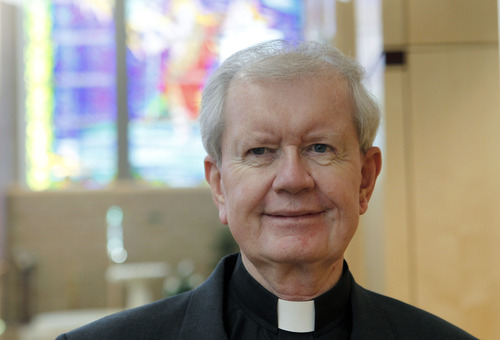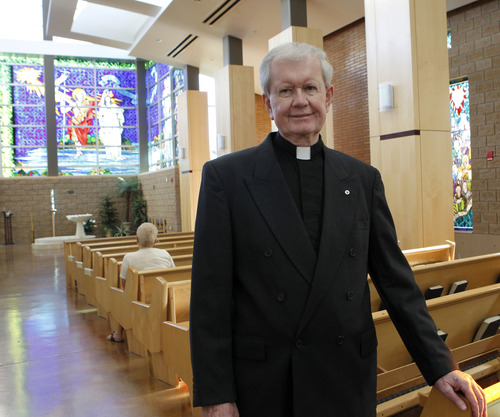This is an archived article that was published on sltrib.com in 2013, and information in the article may be outdated. It is provided only for personal research purposes and may not be reprinted.
Monsignor Terence Moore arrived in Utah from Ireland in 1967 amid the turmoil created by the Second Vatican Council and soon faced a momentous decision: Should he stay a priest or join many of his fellow seminarians marching into the secular universe?
Back home, where priests were plentiful — nearly every Catholic family produced one — the priesthood had seemed a fine way to combine his passion for social work with devotion to his faith. He entered the seminary at age 18 for six years of religious and philosophical training.
When he got out, Moore wanted to find a "missionary diocese" where he might be needed, so he was naturally intrigued when an Ogden priest gave a lively recruitment speech, assuring the young priests they would never work harder than in the Beehive State far across the sea. Moore was hooked, and, except for more schooling, he never left Utah.
Some 46 years later, the 70-year-old Moore is retiring from full-time work as a priest, saying his last Masses as pastor at St. John the Baptist Parish in Draper this weekend.
His career among the Catholics — and Mormons — of Utah has been all he could hope for, he says now, but it was never guaranteed.
"Some priests say, 'I became a priest and never looked back,' " Moore says. "I'm not one of those. I've had questions about whether this was the right vocation for me."
What saved him for the priesthood was the chance to work with some of the state's most vulnerable residents.
"If I had issues with the institutional church," he says, "I had my social services role that kept me focused."
Moore's first assignment was in Salt Lake City's Cathedral of the Madeleine, a stunning symbol of Catholic presence in Mormon-dominated Utah. There, in the stifling sanctuary without air conditioning, the young priest learned about pastoral ministry to the downtrodden.
From there, Moore got involved in what was then the "Chicano movement," ministering to migrant workers and other Latino immigrants. He also helped out with Guadalupe schools for the Spanish-speaking Catholic kids.
Given his interest in social work, Utah's then-bishop, Joseph Federal, sent the Irish priest to get a master's degree in the subject at Catholic University in Washington, D.C. It was the bishop's intention to groom Moore for work at Utah's Catholic Charities.
When he returned, though, he was assigned to the St. Catherine of Siena Newman Center adjacent to the University of Utah.
"I loved that assignment," he recalls, describing conversations with thoughtful, eager Catholic students.
Later, he did work with the church's charities, with its refugee population and with its schools.
Then he went for more schooling, this time earning a doctorate in social work at the U., and has received many awards for his civic and church work.
Meanwhile, Moore built warm relationships with his LDS neighbors and leaders.
When he arrived in Utah, he knew little about The Church of Jesus Christ of Latter-day Saints or the Mormons.
Unlike his home country, where priests were a constant presence on the streets and in homes, Moore felt out of place walking around in his dark suit and white collar.
Before long, though, he was reaching out and making friends across religious borders. Eventually, he became fast friends with now-LDS Church President Thomas S. Monson, who was the liaison with Catholic Charities on issues like the homeless. Moore is even mentioned in Monson's biography, To the Rescue.
When Moore was diagnosed with leukemia, his friend Sam Granato, Mormon politician and businessman, contacted Monson, who asked to see the priest.
The same February 2008 week that Monson became the LDS Church's 16th president, Granato and Moore were in the Mormon leader's office.
The church president anointed Moore with holy oil and gave him a "priesthood blessing," the priest recalls. "It was a wonderful spiritual experience for me."
Such bonds and connections are typical for Moore, says longtime friend Deacon Paul Graham.
"He has instilled in his parishioners that caring for others is not an option," Graham says. "It's a mandate."
Graham says the friendly Irishman, with a self-deprecating sense of humor and gentle conversational style, has inspired many young people to serve in Third World countries.
Moore was the one who set Graham on the road to become a deacon.
"He is my ideal of what a pastor should be," the deacon says. "I came to think maybe I could follow his example."
Though Moore has to take a chemo pill every day, and also has cardiomyopathy, he is not planning to lie around all day. He will help out in the parish, read more books, go to movies and work on his golf game — including that hole-in-one-skill.
In the fall, he will lead a group to Lourdes, the sacred Catholic site in France, where the Virgin Mary is said to heal people.
He laughs at the thought he will be seeking a spiritual solution to his medical woes, but the priest acknowledges almost sheepishly that he does believe in miracles.
"I would love to have a few years of good health," Moore says, "to enjoy my retirement."
But this trip, he says modestly, and indeed his whole career, is not about him.









